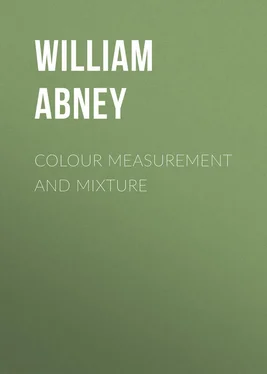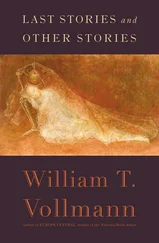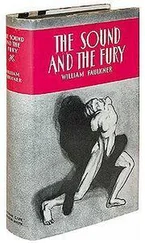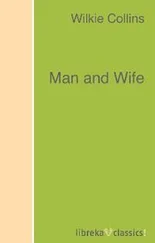William Abney - Colour Measurement and Mixture
Здесь есть возможность читать онлайн «William Abney - Colour Measurement and Mixture» — ознакомительный отрывок электронной книги совершенно бесплатно, а после прочтения отрывка купить полную версию. В некоторых случаях можно слушать аудио, скачать через торрент в формате fb2 и присутствует краткое содержание. Жанр: foreign_antique, foreign_prose, на английском языке. Описание произведения, (предисловие) а так же отзывы посетителей доступны на портале библиотеки ЛибКат.
- Название:Colour Measurement and Mixture
- Автор:
- Жанр:
- Год:неизвестен
- ISBN:нет данных
- Рейтинг книги:3 / 5. Голосов: 1
-
Избранное:Добавить в избранное
- Отзывы:
-
Ваша оценка:
- 60
- 1
- 2
- 3
- 4
- 5
Colour Measurement and Mixture: краткое содержание, описание и аннотация
Предлагаем к чтению аннотацию, описание, краткое содержание или предисловие (зависит от того, что написал сам автор книги «Colour Measurement and Mixture»). Если вы не нашли необходимую информацию о книге — напишите в комментариях, мы постараемся отыскать её.
Colour Measurement and Mixture — читать онлайн ознакомительный отрывок
Ниже представлен текст книги, разбитый по страницам. Система сохранения места последней прочитанной страницы, позволяет с удобством читать онлайн бесплатно книгу «Colour Measurement and Mixture», без необходимости каждый раз заново искать на чём Вы остановились. Поставьте закладку, и сможете в любой момент перейти на страницу, на которой закончили чтение.
Интервал:
Закладка:
The drawback to the use of prisms is that the dispersion of the red end of the spectrum is much less than that of the blue end, and is apt to give a false impression as to the relative luminosities of, and length of spectrum occupied by, the different colours. In some text-books it is told us that the diffraction grating gives us a dispersion which is in exact relation to the wave-length. This is not true, however, as it can only give one small portion in such relationship, and that only when it is specially set for the purpose. The subject of diffraction is one into which it would be foreign to our purpose to wander. We may say that for measures such as we shall make, it is handier to employ prisms, as the prismatic spectrum is more intense than the diffraction spectrum. This can be readily understood when we consider the subject even superficially. If we throw a beam of light on a grating which contains perhaps some 14,000 parallel lines in the space of one inch in width, the lines being ruled on a plane and bright metallic surface, and receive the reflected beam on a screen, the appearance that is presented is a white central spot, together with six or seven spectra of gradually diminishing brightness on each side of it, all except the first pair overlapping one another. That these different spectra do exist can be readily shown by placing in the beam a piece of red glass, when symmetrical pairs of the red part of the spectrum will be found, one of each pair being on opposite sides of what will now be the central red spot. Half the light falling on the grating is concentrated in this central spot, and the remaining half goes to form the spectra; the pair nearest the central spot being the brightest. We thus are drawn to the conclusion that at the outside we can only have less than one-quarter of the incident light to form the brightest spectrum we can use. With two good prisms we use at last three-fourths of the incident light, so that for the same length of spectrum we can get at least three times the average brightness that we should get were we to employ a diffraction grating.
We must now refresh the reader's memory with a few simple facts about light, in order that our meaning may be clear when we speak of rays of different wave-lengths. Every colour in the spectrum has a different wave-length, and it is owing to this difference in wave-length that we are able to separate them by refraction, or diffraction, and to isolate them. Light, or indeed any radiation, is caused by a rhythmic oscillation of the impalpable medium which we, for want of a better term, call ether, and the distance between two of these waves which are in the same phase is called the wave-length of the particular radiation. The extent of the oscillation is called the amplitude, which when squared is in effect a measure of the intensity of the radiation. Thus at sea the distance between the crests of two waves is the wave-length, and the height from trough to crest the amplitude; and the intensity, or power of doing work, of two waves of the same wave-lengths but of different heights, is as the square of their heights. Thus, if the height of one were one unit, and of the other two units, the latter could do four times more work than the former. The waves of radiation which give the sensation of colour in the spectrum vary in length, not perhaps to the extent that might be imagined, considering the great difference that is perceived by the eye, but still they are markedly different. The fact that the spectrum of sunlight is not continuous, but is broken up by innumerable fine lines, has already been alluded to. The position of these lines is always the same, as regards the colour in which they are situated, and is absolutely fixed directly we know their wave-length; hence if we know the wave-lengths of these lines, we can refer the colour in which they lie to them. Now some lines of the solar-spectrum are blacker and consequently more marked than others, and instead of referring the colours to the finer lines, we can refer them to the distance they are from one or more of these darker lines, where these latter are absolutely fixed; in fact they act as mile-stones on a road.
In the red we have three lines in the solar spectrum, which for sake of easy reference are called A, B and C; in the orange we have a line called D, in the green a line called E, in the blue F, in the violet G, and in the extreme violet H. These lines are our fiducial lines, and all colours can be referred to them. The following are the wave-lengths of these lines, on the scale of 1/10,000,000of a millimetre as a unit

When the spectrum is produced by prisms the intervals between these lines are not proportional to the wave-lengths, and consequently if we measure the distance of a ray in the spectrum from two of these lines, we have to resort to calculation, or to a graphically drawn curve, to ascertain its wave-length. For the purpose of experiments in colour the graphic curve from which the wave-length can immediately be read off is sufficient. The following diagram ( Fig. 3) shows how this can be done.
The names and range of the principal colours which are seen in the spectrum has been a matter of some controversy. Professor Rood has, however, made observations which may be accepted as correct with a moderately bright spectrum. If the spectrum be divided into 1000 parts between A in the red, and H, the limit of the violet, he makes the following table of colours.

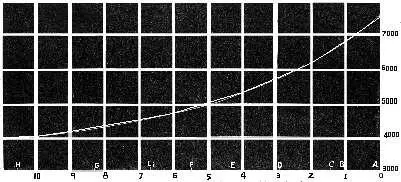
Fig. 3. – Curve for converting the Prismatic Spectrum into Wave-lengths.
In the above scale (Fig. 3) A = 0, B = 74·0, C = 112·7, D = 220·3, E = 363·1, F = 493·2, G = 753·6, H = 1000.
These are the main subdivisions of colour, but it must be recollected that one melts into the other. When the spectrum is very bright the colours tend to alter in hue; thus the orange becomes paler, and the yellow whiter, and the blue paler. On the other hand, if the spectrum be diminished in brightness the tendency is for the colours to change in the opposite direction. Thus the yellow almost disappears and becomes of a green hue, whilst the orange becomes redder, and the spectrum itself becomes shorter to the eye than before.
Let us strictly guard ourselves, however, from the criticism that all eyes see not alike. Suffice it to say that the above table is correct for the ordinary or normal eye, and does not necessarily apply to those who have defective vision as regards colour sensation.
CHAPTER III
The Visible and Invisible Parts of the Spectrum – Methods for showing the Existence of the Invisible Portions – Phosphorescence – Photography of the Dark Rays – Thermo-Electric Currents.
We are apt to forget, when looking at the spectrum, that what the eye sees is not all that is to be found in the prismatic analysis of light. The spectrum, it must be recollected, is not limited to those rays which the eye perceives. There are rays both beyond the extreme violet and below the extreme red, which exist and which exercise a marked effect on the world's economy. Thus, rays beyond the violet are those which with the violet and the blue rays principally affect vegetation, enabling certain chemical changes to take place which are necessary for its growth and health; whilst the rays below the red are those possessing the greatest amount of energy, and if they fall upon bodies which absorb them, as very nearly all bodies do to a certain extent, they heat them. The warmth we feel from sunlight is principally due to the dark rays which lie below the red of the spectrum.
Читать дальшеИнтервал:
Закладка:
Похожие книги на «Colour Measurement and Mixture»
Представляем Вашему вниманию похожие книги на «Colour Measurement and Mixture» списком для выбора. Мы отобрали схожую по названию и смыслу литературу в надежде предоставить читателям больше вариантов отыскать новые, интересные, ещё непрочитанные произведения.
Обсуждение, отзывы о книге «Colour Measurement and Mixture» и просто собственные мнения читателей. Оставьте ваши комментарии, напишите, что Вы думаете о произведении, его смысле или главных героях. Укажите что конкретно понравилось, а что нет, и почему Вы так считаете.
